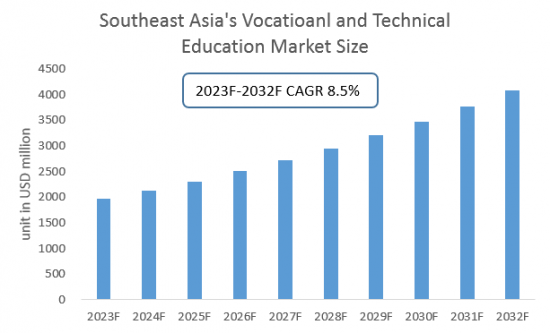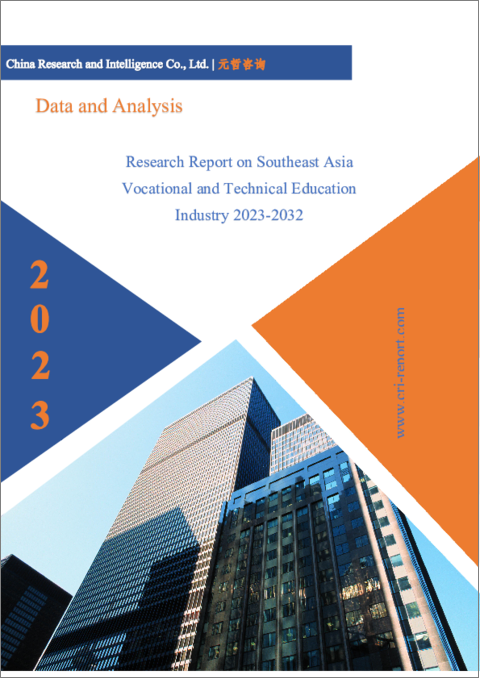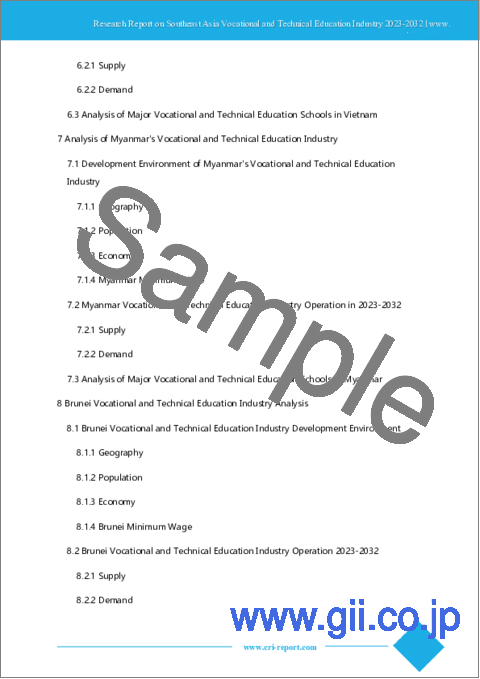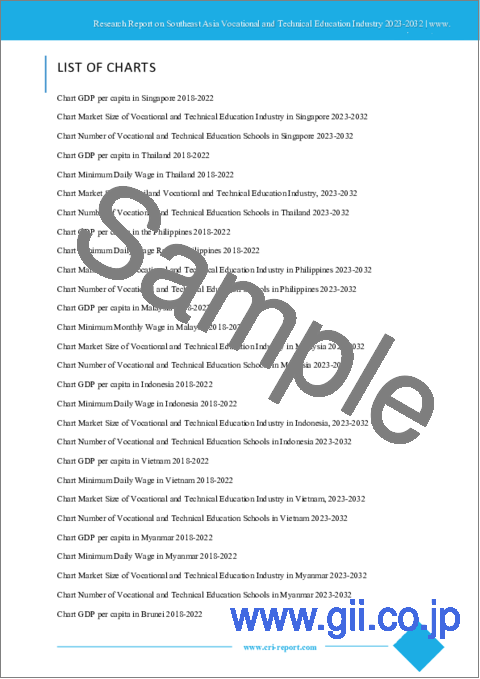|
|
市場調査レポート
商品コード
1231847
東南アジアの職業教育・技術教育産業(2023年~2032年)Research Report on Southeast Asia Vocational and Technical Education Industry 2023-2032 |
||||||
| 東南アジアの職業教育・技術教育産業(2023年~2032年) |
|
出版日: 2023年03月01日
発行: China Research and Intelligence
ページ情報: 英文 80 Pages
納期: 即日から翌営業日
|
- 全表示
- 概要
- 目次
東南アジアの経済は依然として強い成長可能性を持っており、大半の部門がまだ発展途上または発展段階にあるため、熟練した人材に対する需要が徐々に高まっています。
当レポートでは、東南アジアの職業教育・技術教育産業について調査分析し、主な促進要因、課題と機会、COVID-19の影響などの情報を提供しています。
目次
第1章 シンガポールの職業教育・技術教育産業の分析
- シンガポールの職業教育・技術教育産業の開発環境
- 地域
- 人口
- 経済
- シンガポールの最低賃金
- シンガポールの職業教育・技術教育産業の経営(2023年~2032年)
- 供給
- 需要
- シンガポールの主な職業教育・技術教育学校の分析
第2章 タイの職業教育・技術教育産業の分析
- タイの職業教育・技術教育産業の開発環境
- 地域
- 人口
- 経済
- タイの最低賃金
- タイの職業教育・技術教育産業の経営(2023年~2032年)
- 供給
- 需要
- タイの主な職業教育・技術教育学校の分析
第3章 フィリピンの職業教育・技術教育産業の分析
- フィリピンの職業教育・技術教育産業の開発環境
- 地域
- 人口
- 経済
- フィリピンの最低賃金
- フィリピンの職業教育・技術教育産業の経営(2023年~2032年)
- 供給
- 需要
- フィリピンの主な職業教育・技術教育学校の分析
第4章 マレーシアの職業教育・技術教育産業の分析
- マレーシアの職業教育・技術教育産業の開発環境
- 地域
- 人口
- 経済
- マレーシアの最低賃金
- マレーシアの職業教育・技術教育産業の経営(2023年~2032年)
- 供給
- 需要
- マレーシアの主な職業教育・技術教育学校の分析
第5章 インドネシアの職業教育・技術教育産業の分析
- インドネシアの職業教育・技術教育産業の開発環境
- 地域
- 人口
- 経済
- インドネシアの最低賃金
- インドネシアの職業教育・技術教育産業の経営(2023年~2032年)
- 供給
- 需要
- インドネシアの主な職業教育・技術教育学校の分析
第6章 ベトナムの職業教育・技術教育産業の分析
- ベトナムの職業教育・技術教育産業の開発環境
- 地域
- 人口
- 経済
- ベトナムの最低賃金
- ベトナムの職業教育・技術教育産業の経営(2023年~2032年)
- 供給
- 需要
- ベトナムの主な職業教育・技術教育学校の分析
第7章 ミャンマーの職業教育・技術教育産業の分析
- ミャンマーの職業教育・技術教育産業の開発環境
- 地域
- 人口
- 経済
- ミャンマーの最低賃金
- ミャンマーの職業教育・技術教育産業の経営(2023年~2032年)
- 供給
- 需要
- ミャンマーの主な職業教育・技術教育学校の分析
第8章 ブルネイの職業教育・技術教育産業の分析
- ブルネイの職業教育・技術教育産業の開発環境
- 地域
- 人口
- 経済
- ブルネイの最低賃金
- ブルネイの職業教育・技術教育産業の経営(2023年~2032年)
- 供給
- 需要
- ブルネイの主な職業教育・技術教育学校の分析
第9章 ラオスの職業教育・技術教育産業の分析
- ラオスの職業教育・技術教育産業の開発環境
- 地域
- 人口
- 経済
- ラオスの最低賃金
- ラオスの職業教育・技術教育産業経営(2023年~2032年)
- 供給
- 需要
- ラオスの主な職業教育・技術教育学校の分析
第10章 カンボジアの職業教育・技術教育産業の分析
- カンボジアの職業教育・技術教育産業の開発環境
- 地域
- 人口
- 経済
- カンボジアの最低賃金
- カンボジアの職業教育・技術教育産業の経営(2023年~2032年)
- 供給
- 需要
- カンボジアの主な職業教育・技術教育学校の分析
第11章 東南アジアの職業教育・技術教育産業の見通し(2023年~2032年)
- 東南アジアの職業教育・技術教育産業の発展に影響を与える要因の分析
- 有利な要因
- 不利な要因
- 東南アジアの職業教育・技術教育産業の供給の分析(2023年~2032年)
- 東南アジアの職業教育・技術教育産業の需要の分析(2023年~2032年)
- 職業教育・技術教育産業に対するCOVID-19流行の影響
With the economic development of Southeast Asia, various fields are thriving and technology is constantly updated, but there is a shortage of talents in some industries, and a large number of people with relevant skills are needed to enter the industry. With a large population and a young demographic structure in Southeast Asia, the population of Generation Z is about 160 million, accounting for about 24% of the total population, and the future development of vocational and technical education has a bright future.
SAMPLE VIEW

In 2017, the Southeast Asian Ministers of Education Organization (SEAMEO) held an international conference at its headquarters in Thailand to include TVET as a priority project, focusing on the training of vocational and technical personnel in tourism, manufacturing, agriculture and construction. According to CRI's analysis, the Southeast Asian vocational and technical education sector has a wide range of development levels in different countries. Taking Singapore as an example, Singapore's vocational education system has become more mature, and based on international experience, it has established a modern vocational education system that is adapted to modern economic development, oriented to the needs of business and industry, progressive and interconnected with various types of education, and set up craft education colleges, polytechnics and various training institutions to provide students with skills and knowledge learning in an occupational cluster.
Southeast Asia in this report includes 10 countries: Singapore, Thailand, Philippines, Malaysia, Indonesia, Vietnam, Myanmar, Brunei, Laos and Cambodia. With a total population of over 600 million by the end of 2021, Southeast Asia has an overall economic growth rate higher than the global average and is one of the key drivers of future global economic growth.
According to CRI's analysis, the economic levels of the 10 Southeast Asian countries vary greatly, with Singapore being the only developed country with a per capita GDP of about US$73,000 in 2021. While Myanmar and Cambodia will have a GDP per capita of less than US$2,000 in 2021. The population and minimum wage levels of each country also vary greatly. Brunei, which has the smallest population, will have a total population of less than 500,000 people in 2021, while Indonesia, which has the largest population, will have a population of about 275 million people in 2021.
Southeast Asian economies still have strong growth potential, and most sectors are still in their infancy or developmental stages, with demand for skilled personnel gradually increasing. CRI expects the Southeast Asian vocational and technical education industry to continue to grow from 2023-2032.
Topics covered:
- Southeast Asia Vocational and Technical Education Industry Status and Major Sources in 2018-2022
- What is the Impact of COVID-19 on Southeast Asia Vocational and Technical Education Industry?
- Which Companies are the Major Players in Southeast Asia Vocational and Technical Education Industry Market and What are their Competitive Benchmarks?
- Key Drivers and Market Opportunities in Southeast Asia Vocational and Technical Education Industry
- What are the Key Drivers, Challenges, and Opportunities for Southeast Asia Vocational and Technical Education Industry during 2023-2032?
- What is the Expected Revenue of Southeast Asia Vocational and Technical Education Industry during 2023-2032?
- What are the Strategies Adopted by the Key Players in the Market to Increase Their Market Share in the Industry?
- What are the Competitive Advantages of the Major Players in Southeast Asia Vocational and Technical Education Industry Market?
- Which Segment of Southeast Asia Vocational and Technical Education Industry is Expected to Dominate the Market in 2032?
- What are the Major Adverse Factors Facing Southeast Asia Vocational and Technical Education Industry?
Table of Contents
1 Analysis of the Vocational and Technical Education Industry in Singapore
- 1.1 Development Environment of Vocational and Technical Education Industry in Singapore
- 1.1.1 Geography
- 1.1.2 Population
- 1.1.3 Economy
- 1.1.4 Minimum Wage in Singapore
- 1.2 Singapore Vocational and Technical Education Industry Operation 2023-2032
- 1.2.1 Supply
- 1.2.2 Demand
- 1.3 Analysis of Major Vocational and Technical Education Schools in Singapore
2 Analysis of the Vocational and Technical Education Industry in Thailand
- 2.1 Development Environment of the Vocational and Technical Education Industry in Thailand
- 2.1.1 Geography
- 2.1.2 Population
- 2.1.3 Economy
- 2.1.4 Thailand Minimum Wage
- 2.2 Thailand's Vocational and Technical Education Industry Operation 2023-2032
- 2.2.1 Supply
- 2.2.2 Demand
- 2.3 Analysis of Major Vocational and Technical Education Schools in Thailand
3 Analysis of the Vocational and Technical Education Industry in the Philippines
- 3.1 Development Environment of the Vocational and Technical Education Industry in the Philippines
- 3.1.1 Geography
- 3.1.2 Population
- 3.1.3 Economy
- 3.1.4 Minimum Wage in the Philippines
- 3.2 Philippine Vocational and Technical Education Industry Operation 2023-2032
- 3.2.1 Supply
- 3.2.2 Demand
- 3.3 Analysis of Major Vocational and Technical Education Schools in the Philippines
4 Analysis of Malaysia's Vocational and Technical Education Industry
- 4.1 Malaysia Vocational and Technical Education Industry Development Environment
- 4.1.1 Geography
- 4.1.2 Population
- 4.1.3 Economy
- 4.1.4 Minimum Wage in Malaysia
- 4.2 Malaysian Vocational and Technical Education Industry Operation 2023-2032
- 4.2.1 Supply
- 4.2.2 Demand
- 4.3 Analysis of Major Vocational and Technical Education Schools in Malaysia
5 Indonesia Vocational and Technical Education Industry Analysis
- 5.1 Development Environment of Vocational and Technical Education Industry in Indonesia
- 5.1.1 Geography
- 5.1.2 Population
- 5.1.3 Economy
- 5.1.4 Minimum Wage in Indonesia
- 5.2 Indonesia Vocational and Technical Education Industry Operation 2023-2032
- 5.2.1 Supply
- 5.2.2 Demand
- 5.3 Analysis of Major Vocational and Technical Education Schools in Indonesia
6 Analysis of Vocational and Technical Education Industry in Vietnam
- 6.1 Development Environment of Vocational and Technical Education Industry in Vietnam
- 6.1.1 Geography
- 6.1.2 Population
- 6.1.3 Economy
- 6.1.4 Minimum Wage in Vietnam
- 6.2 Vietnam's Vocational and Technical Education Industry Operation 2023-2032
- 6.2.1 Supply
- 6.2.2 Demand
- 6.3 Analysis of Major Vocational and Technical Education Schools in Vietnam
7 Analysis of Myanmar's Vocational and Technical Education Industry
- 7.1 Development Environment of Myanmar's Vocational and Technical Education Industry
- 7.1.1 Geography
- 7.1.2 Population
- 7.1.3 Economy
- 7.1.4 Myanmar Minimum Wage
- 7.2 Myanmar Vocational and Technical Education Industry Operation in 2023-2032
- 7.2.1 Supply
- 7.2.2 Demand
- 7.3 Analysis of Major Vocational and Technical Education Schools in Myanmar
8 Brunei Vocational and Technical Education Industry Analysis
- 8.1 Brunei Vocational and Technical Education Industry Development Environment
- 8.1.1 Geography
- 8.1.2 Population
- 8.1.3 Economy
- 8.1.4 Brunei Minimum Wage
- 8.2 Brunei Vocational and Technical Education Industry Operation 2023-2032
- 8.2.1 Supply
- 8.2.2 Demand
- 8.3 Analysis of Major Vocational and Technical Education Schools in Brunei
9 Analysis of the Vocational and Technical Education Industry in Laos
- 9.1 Development Environment of the Vocational and Technical Education Industry in Laos
- 9.1.1 Geography
- 9.1.2 Population
- 9.1.3 Economy
- 9.1.4 Minimum Wage in Laos
- 9.2 Lao Vocational and Technical Education Industry Operation 2023-2032
- 9.2.1 Supply
- 9.2.2 Demand
- 9.3 Analysis of Major Vocational and Technical Education Schools in Laos
10 Analysis of the Vocational and Technical Education Industry in Cambodia
- 10.1 Development Environment of Vocational and Technical Education Industry in Cambodia
- 10.1.1 Geography
- 10.1.2 Population
- 10.1.3 Economy
- 10.1.4 Minimum Wage in Cambodia
- 10.2 Cambodia Vocational and Technical Education Industry Operation in 2023-2032
- 10.2.1 Supply
- 10.2.2 Demand
- 10.3 Analysis of Major Vocational and Technical Education Schools in Cambodia
11 Southeast Asia Vocational and Technical Education Industry Outlook 2023-2032
- 11.1 Analysis of Factors Influencing the Development of Vocational and Technical Education Industry in Southeast Asia
- 11.1.1 Favorable Factors
- 11.1.2 Unfavorable Factors
- 11.2 Supply Analysis of Southeast Asian Vocational and Technical Education Industry 2023-2032
- 11.3 Southeast Asia Vocational and Technical Education Industry Demand Analysis 2023-2032
- 11.4 Impact of COVID -19 Epidemic on Vocational and Technical Education Industry




